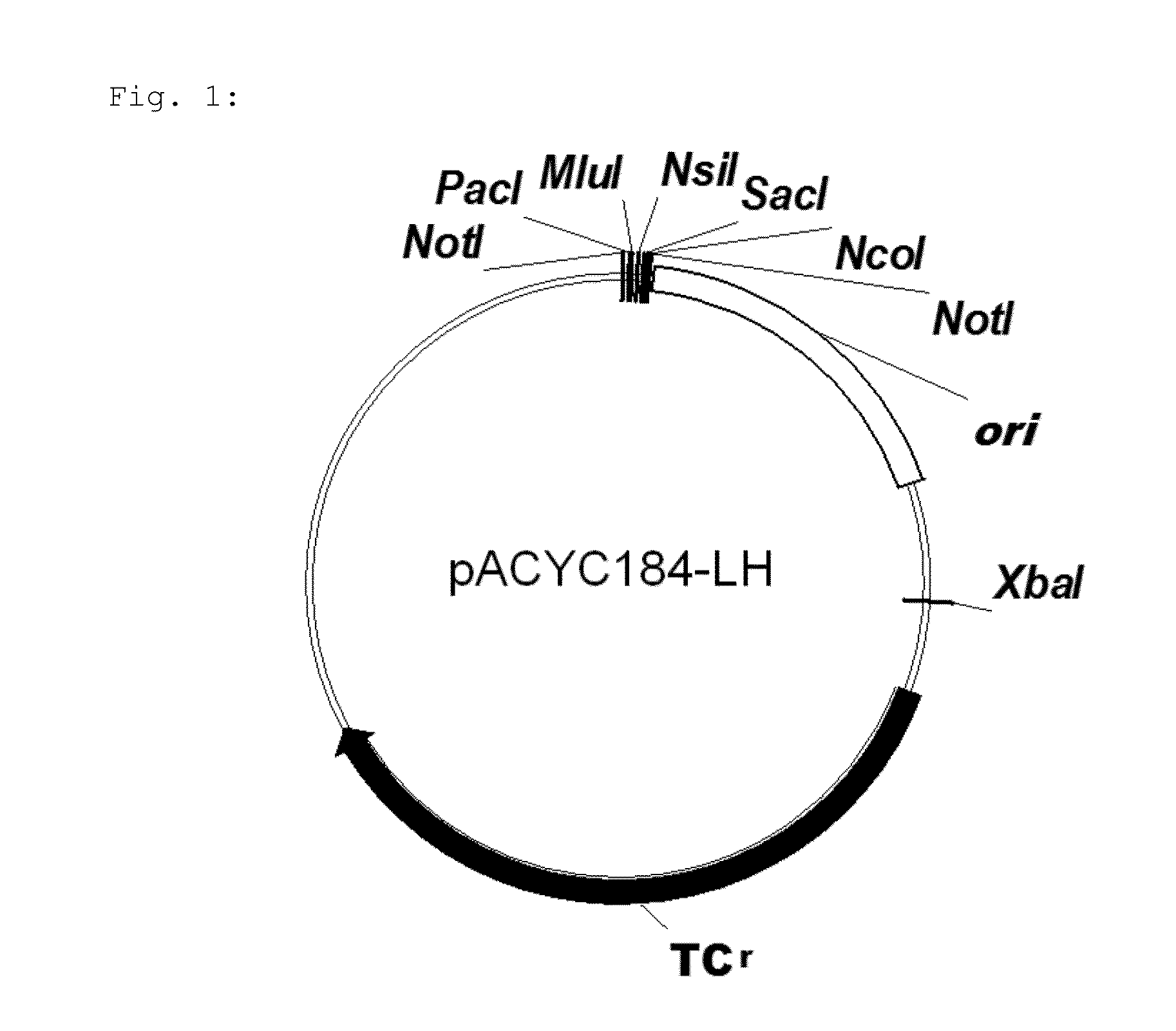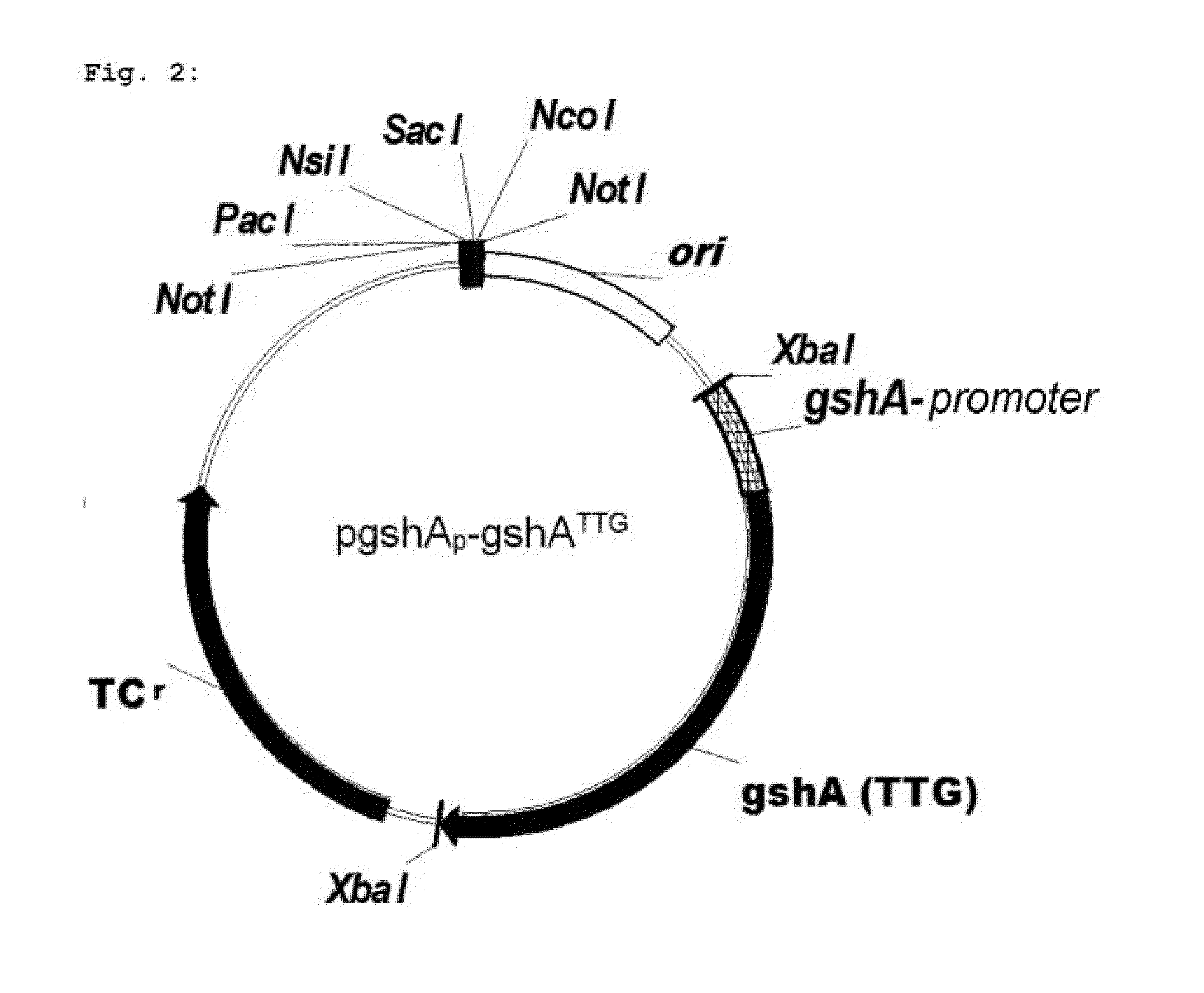Microorganism and method for overproduction of gamma-glutamylcysteine and derivatives of this dipeptide by fermentation
a technology of gamma-glutamylcysteine and fermentation, which is applied in the field of microorganisms and methods for overproduction of gamma-glutamylcysteine and derivatives of this dipeptide by fermentation, can solve the problems of reduced susceptibility, and reduced glutathione synthetase activity of cells
- Summary
- Abstract
- Description
- Claims
- Application Information
AI Technical Summary
Benefits of technology
Problems solved by technology
Method used
Image
Examples
example 1
Deletion of the Gene gshB (Gutathione Synthetase Inactivation) in the E. coli Strain W3110 (ATCC27325)
[0083]The gene gshB, which codes for the enzyme glutathione synthetase (GshB) in E. coli, was deleted in the E. coli strain W3110 (ATCC27325) according to the “A-Red Method” developed by Datsenko and Wanner (Datsenko and Wanner, 2000, P.N.A.S. 97: 6640-6645). A DNA fragment, which codes for the kanamycin resistence marker (kanR), was amplified using the primers gshB-del-for (SEQ ID No. 5) and gshB-del-rev (SEQ ID No. 6).
[0084]The primer gshB-del-for codes for a sequence consisting of 30 nucleotides, which is homologous to the 5′-end of the gshB gene, and a sequence comprising 20 nucleotides, which is complementary to a DNA sequence which codes one of the two FRT sites (FLP recognition target) on the plasmid pKD13 (Coli Genetic Stock Center (CGSC) No. 7633). The primer gshB-del-rev codes for a sequence consisting of 30 nucleotides, which is homologous to the 3′-end of the gshB gene, ...
example 2
Amplification of the gshA Gene with its Own Promoter
[0086]The promoter sequence of the gshA gene in E. coli is known (Watanabe et al., 1986, Nucleic Acids Res. 14: 4393-4400). A DNA fragment, which codes for the gshA gene and the gshA promoter (gshAp) of E. coli, was amplified by means of PCR. The DNA fragment, which codes for the promoter sequence of the gshA gene, was amplified with the primers gshAp-gshA-for (SEQ ID No. 7) and gshAp-gshA-rev (SEQ ID No. 8). Chromosomal DNA of the E. coli strain W3110 (ATCC 27325) served as template for the PCR reaction.
[0087]The approximately 1.9 kb sized PCR fragment was purified by agarose gel electrophoresis and isolated from the agarose gel using the “QIAquick Gel Extraction Kit” (Qiagen GmbH, Hilden, D) according to the manufacturer's instructions. The purified PCR fragment was then digested with the restriction enzyme XbaI and stored at −20° C.
example 3
Amplification and Mutagenesis of the gshA Gene
[0088]A. Amplification of the gshA gene
[0089]The gshA gene of E. coli was amplified by means of PCR. Chromosomal DNA of the E. coli strain W3110 (ATCC 27325) served as template for the PCR reaction. A Taq polymerase (Qiagen GmbH) was used for the amplification, which attaches an additional adenine at the respective 3′-end of the PCR product. In the course of the amplification of gshA, the uncommon start codon TTG was replaced by start codon ATG by using a suitable primer. The oligonucleotides gshA-OE-for (SEQ ID NO. 9) and gshA-OE-rev (SEQ ID NO. 10) served as specific primers.
[0090]The resulting 1.6 kb sized DNA fragment was purified by agarose gel electrophoresis and isolated from the agarose gel using the “QIAquick Gel Extraction Kit” (Qiagen GmbH). The ligation of the amplified and purified PCR product with the vector pCR2.1-TOPO (Life Technologies, Life Technologies GmbH, Darmstadt, D) was carried out by “TA cloning” using the “TOPO...
PUM
| Property | Measurement | Unit |
|---|---|---|
| Fraction | aaaaa | aaaaa |
| Cell angle | aaaaa | aaaaa |
| Strain point | aaaaa | aaaaa |
Abstract
Description
Claims
Application Information
 Login to View More
Login to View More - R&D
- Intellectual Property
- Life Sciences
- Materials
- Tech Scout
- Unparalleled Data Quality
- Higher Quality Content
- 60% Fewer Hallucinations
Browse by: Latest US Patents, China's latest patents, Technical Efficacy Thesaurus, Application Domain, Technology Topic, Popular Technical Reports.
© 2025 PatSnap. All rights reserved.Legal|Privacy policy|Modern Slavery Act Transparency Statement|Sitemap|About US| Contact US: help@patsnap.com



